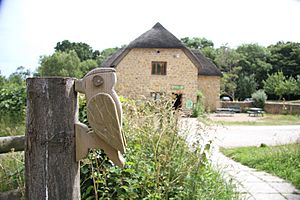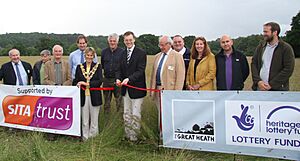Dorset Wildlife Trust facts for kids
Dorset Wildlife Trust (DWT) is a special group that works to protect and care for wildlife and natural places in Dorset, United Kingdom. It's like a superhero team for nature! The trust started in 1961. Back then, it was called Dorset Naturalists' Trust. Its main goal was to save the amazing animals and plants, and their homes, across the county.
DWT is part of a bigger family of 46 local wildlife trusts called The Wildlife Trusts. The main office for DWT is at Brooklands Farm, near Dorchester. DWT has many supporters, including 27,000 members, 65 staff members, and over 850 helpful volunteers. Brian Bleese is the Chief Executive, leading the team since April 2020.
While DWT is famous for its beautiful nature reserves, its work goes much further. They also teach people about nature and work with communities. DWT helps wildlife not just in the countryside, rivers, and along the coast, but also in towns, churchyards, and even along roadsides.
A big goal for DWT and other wildlife trusts is to create "living landscapes" and "living seas." These are large areas where both people and wildlife can thrive together. They also help create "wildlife corridors," which are like special pathways for animals to move safely between different natural areas.
DWT also helps create "Nature Parks." These are big areas managed for the good of both people and wildlife. An example is Holes Bay Nature Park in Poole. This park is a team effort involving DWT and other local groups.
Contents
History of Dorset Wildlife Trust
Why DWT Started
In the 1950s and 1960s, many natural places in Dorset were being lost. Huge areas of heathland and chalk downland were disappearing. For example, Dorset's heaths used to cover over 40,000 hectares. By 1960, this had shrunk to about 10,000 hectares. Even more chalk downland was turned into farms for growing crops.
People became very worried that the homes of important plants and animals were vanishing quickly. Because of this, the Dorset Naturalists' Trust was formed. The first meeting was held on March 28, 1961. Helen Brotherton was a key founder and supporter. She worked for the trust for her whole life.
Saving Brownsea Island
Brownsea Island in Poole Harbour was owned by Mary Bonham-Christie. She kept the island private for many years. This meant nature was left to grow wild there. When she passed away in April 1961, people wanted to save the island as a wildlife reserve.
The Dorset Wildlife Trust was just starting around this time. The island was offered for sale, but DWT couldn't afford the £100,000 price tag. However, Helen Brotherton helped arrange a special plan. The National Trust, the Dorset Wildlife Trust, the Boy Scouts Association, and the John Lewis Partnership all worked together. Each group gave money to the National Trust, who then bought the island. This partnership has continued to protect Brownsea Island for many years.
Nature Reserves and Visitor Places
DWT looks after 45 nature reserves. These reserves cover more than 12 square kilometers. They include 25 special places called Sites of Special Scientific Interest. Most of these places are owned by DWT, but some are leased from other landowners. These reserves are very important for protecting local wildlife.
The reserves show off the amazing natural variety of Dorset. You can find chalk grasslands, old meadows, beautiful woodlands, rare heathlands, important wetlands, and even a part of the famous Jurassic Coast. DWT says that over 200,000 people visit their reserves every year.
DWT also has seven special centers where people can learn about wildlife:
- Fine Foundation Wild Seas Centre, Kimmeridge
- The Kingcombe Centre, Lower Kingcombe, Toller Porcorum
- Lorton Meadows Wildlife Centre, Weymouth
- The Villa Wildlife Centre, Brownsea Island
- Urban Wildlife Centre, Corfe Mullen, Poole
- Fine Foundation Wild Chesil Centre, Portland
- Brooklands Farm, which is DWT's main office
Rewilding Projects
In 2021, DWT bought 170 hectares of land at Court Farm, near Bere Regis, Dorset. This land cost £3.8 million. Most of the money came from local councils. The goal was to stop harmful farming practices that were putting too much nitrate into Poole Harbour.
DWT started a project called rewilding on this land. Rewilding means letting nature take over and heal itself. The trust uses natural ways to help the land become wild again. Many local volunteers and the Bere Regis Parish Council have helped a lot with this project.
A kind person named Julia Davies helped DWT buy the land. After talking with DWT members and local people, the site was renamed 'Wild Woodbury'. This new name shows the area's history and its future as a wild place.
The Great Heath Project
In 2013, DWT started a big project called the Great Heath Living Landscape. This was a team effort with many groups, including local councils and other conservation organizations. The project aimed to buy almost 1500 acres of heathland and other natural areas.
The project also included a three-year program to help people visit and learn about these places. It brought together many sites owned and managed by different partners. This project received a lot of funding from the Heritage Lottery Fund and other groups, as well as from community fundraising.
Nature Parks
A key idea for Dorset Wildlife Trust is to create Nature Parks. DWT explains that Nature Parks are places where different landowners and groups work together. They manage an area to protect its special features and make it good for both people and wildlife.
The first Nature Park was Holes Bay Nature Park in Poole Harbour. It started in 2015. This park is a partnership between DWT, Poole Harbour Commissioners, and the Borough of Poole. Many local businesses and community groups also help.
Corfe Barrows Nature Park opened in June 2016. This park is also a partnership of landowners, including Dorset Wildlife Trust and local councils. Improvements like better paths, signs, and information boards were paid for by special funds.



